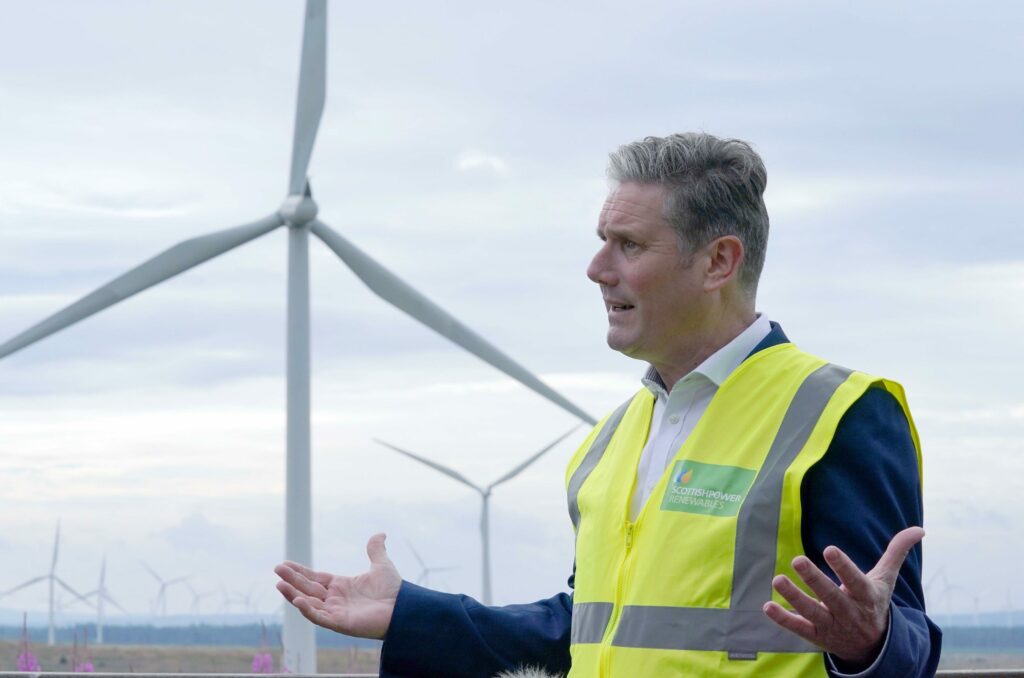
Does Labour have a plan for decarbonising the economy, or a plan for the economy at all? After dropping their signature policy to invest £28bn a year in clean energy and green technologies, the accusations that ‘Labour has no plan’ appear to have more of a bite. But is there more than meets the eye to Labour’s plans for the green economy?
First, where did the £28bn policy go wrong? The pledge was announced in 2021 as the centrepiece of Labour’s ‘Green Prosperity Plan’, designed to drive growth, create jobs and decarbonise the economy. Despite being less than 3 years ago, it was a different political and economic era: Boris Johnson was still in Downing Street, Labour were behind in the polls, and interest rates were close to zero. It was, back then, relatively easy to make the case for big public sector capital investments.
Then Russia’s invasion of Ukraine, the resulting energy crisis, and Liz Truss’s calamitous economic experiment sent borrowing costs through the roof. According to the IFS’s Paul Johnson, borrowing that £28bn a year now would “make offsetting planned cuts in other areas of public spending all but impossible” without tax rises – which Labour regards as political kryptonite. With policy brains with one eye on the desperate state of public services and the other on the Shadow Chancellor, Rachel Reeves’s fiscal rules, and with political strategists all-too aware of Labour’s unrivalled ability to snatch defeat from the jaws of victory, the £28bn pledge was seen as too big a vulnerability, so it had to go. Dropping it was painful – but not as painful as keeping it.
But the headline £28bn figure was not the only plank in Labour’s raft of green policy. Several impactful elements of their plan remain.
First is reforming the planning system… – which Rachel Reeves, railed against in her recent Mais Lecture as “the single greatest obstacle to our economic success”, making UK infrastructure much more expensive than in most other developed countries. An updated planning regime for Nationally Significant Infrastructure Projects will be foremost in Labour’s economic plan.
Second, Labour plans to reform electricity grid connections – currently a huge blocker to renewable energy development – by making the grid development contestable, so it is not purely the domain of National Grid.
While clearing those obstacles is crucial, they can’t decarbonise the economy, alone. Money, as ever, is still key.
So the third part of Labour’s answer lies in its National Wealth Fund, an £8bn-a-year investment programme earmarked for green steel, floating offshore wind, ports, gigafactories and so on – the major projects that will unlock larger transformations throughout the economy. This is ‘catalytic public investment’, meaning for every £1 of public money invested, Labour expects to attract another £3 of private investment.
Somewhere alongside the National Wealth Fund sits GB Energy. This proposed state-owned company will invest in clean energy projects explicitly with the purpose of retaining the profits for UK taxpayers – rather than so many foreign state-owned companies currently invested in UK energy assets. But specifics on how GB Energy will operate or be funded, or to what extent it will work in partnership or in competition with the private sector, remain fuzzy at best. Some industry figures worry GB Energy will crowd out private investment right when Labour are trying to crowd it in through other routes.


One of those routes is pension reform. Reeves is looking at tweaking the rules governing the UK’s defined-contribution pension funds, worth nearly £1tr. Reeves plans to encourage the consolidation of these funds, and drive more of their ‘patient capital’ into UK assets like infrastructure projects. Alongside that, stronger sustainability requirements on financial institutions, and a UK Green Taxonomy will drive more transparent sustainable investing across the board.
Other ideas are under discussion. At Blakeney’s Green Prosperity Summit last month, which we co-hosted with Octopus Energy, global investment and clean energy CEOs met with Reeves and Ed Miliband to identify further barriers to investment, and how they could be knocked down. While clarity on issues like electrification and locational pricing are front-of-mind among clean energy bosses, for investors the key is consistency, confidence, careful tweaks and guarantees. But little of that makes for eye-catching manifesto promises like a few billion pounds of public money does.
Labour continues to see energy and climate change as an important political dividing line, so we’ll certainly see more before the election. But with Starmer and Reeves more politically and fiscally constrained than their 20pt polling lead suggests, further public spending pledges are likely to be measured in single-digit billions, not in the tens of billions.
Will that satisfy every green economy stakeholder? No. But with the public purse strings pulled so tight, the only way for Labour to deliver on its green ambitions is by convincing investors to turn on the taps – or, at this rate, a firehose.